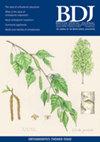Endodontic S3-level clinical practice guidelines: the European Society of Endodontology process and recommendations
IF 2
4区 医学
Q2 DENTISTRY, ORAL SURGERY & MEDICINE
引用次数: 0
Abstract
The European Society of Endodontology (ESE) published quality guidelines in 2006; however, they had not been revised since. In line with a state-of the art guideline process, the first S3-level clinical practice guideline (CPG) in endodontics was published by the ESE in 2023. The aim was to systemically develop, using a rigorous validated methodology, an S3-level guideline for the management of endodontic disease which concentrated on diagnosis and the therapeutic approaches required to deal with patients with pulpitis and apical periodontitis. Methodologically, this ESE CPG was developed with the assistance of experts from other dental disciplines and with independent methodological guidance. A systematic literature appraisal process included the analysis of comparative research in 14 specific areas that would be described in 14 systematic reviews prior to investigation of evidence''s quality and strength. Finally, a series of expert and evidence-based recommendations were agreed by consensus with endodontists and a range of external stakeholders. The resulting clinical recommendations address the effectiveness of diagnosing pulpitis and apical periodontitis before recommendations are made on the effectiveness of endodontic management strategies in treatment of these diseases. Based on robust evidence, recommendations cover the effectiveness of vital pulp treatment, non-surgical and surgical management, as well as regenerative strategies to address endodontic disease. Within the guidelines, the critical importance of clinical history, asepsis, appropriate training and re-evaluation during and after treatment are underlined. In conclusion, this clinical endodontic guideline informs practice, policymakers, stakeholders and patients on the most effective treatments to manage patients with pulpitis and apical periodontitis, while highlighting critical areas for further research.

求助全文
约1分钟内获得全文
求助全文
来源期刊

British Dental Journal
医学-牙科与口腔外科
CiteScore
3.10
自引率
15.40%
发文量
1096
审稿时长
4-8 weeks
期刊介绍:
The role of the BDJ is to inform its readers of ideas, opinions, developments and key issues in dentistry - clinical, practical and scientific - stimulating interest, debate and discussion amongst dentists of all disciplines. All papers published in the BDJ are subject to rigorous peer review.
 求助内容:
求助内容: 应助结果提醒方式:
应助结果提醒方式:


